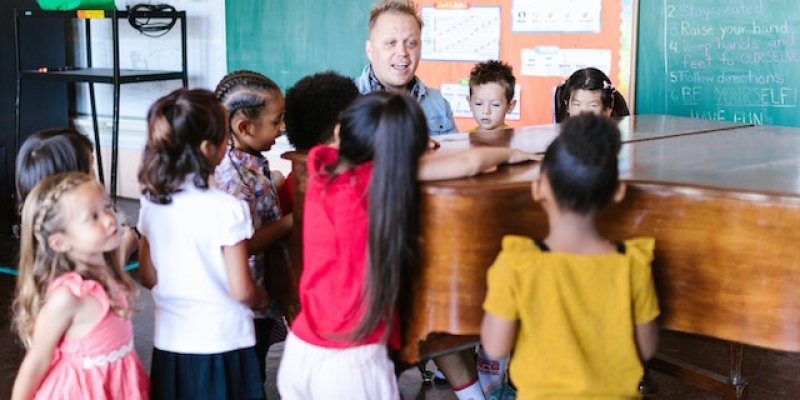
Vocal warm-ups are highly beneficial for kids before singing. Just like athletes warm up their bodies before physical activity, vocal warm-ups help prepare the voice, improve vocal technique, and enhance overall performance.
Implementing vocal warm-ups into your teaching routine gives your kid a strong foundation for healthy singing habits, pitch accuracy, clear diction, and increased confidence.
These benefits will not only enhance their singing abilities but also contribute to their overall musical development.
One of the challenges with warming up youngsters' voices is that you want to keep them excited and involved.
Vocal warm-ups like the ones below are enjoyable and engaging for kids, encouraging participation and keeping the warm-up process fun and exciting for everyone involved!
Have the kids press their lips together and make buzzing sounds as they exhale. This exercise helps relax and warm up the lips, preparing the vocal folds for singing. Lip trills also encourage airflow and help develop lip and facial muscle control.
Related Post: 41 Hilariously Corny Music Jokes For Kids
Starting at the bottom of their range, the kids smoothly slide their voices up to the top and back down, imitating the sound of a siren.
This playful warm-up helps develop flexibility, range, and vocal control. It also encourages exploring different volumes and speeds, fostering a sense of vocal expression.
Make singing fun by imitating different animal noises using different parts of the voice. Meow like a cat, woof like a dog, or tweet like a bird!
This activity engages the imagination, vocalizes different vowel sounds, and promotes vocal exploration. It's a great way to develop creativity and expressiveness.
Engage in tongue twisters like "Unique New York" or "Red Leather, Yellow Leather" to improve diction and articulation.
Repeat these challenging phrases, focusing on clear pronunciation and accuracy. Tongue twisters also promote tongue agility and coordination, helping kids develop clear and precise speech.
Related Post: 10 Tongue Twisters For Rappers And Singers
Sing short phrases and have the kids echo them back. This activity improves listening skills, pitch matching, and vocal imitation.
It helps develop a sense of musicality, encourages active engagement with vocal patterns, and fosters a sense of harmony and ensemble singing.
Related Post: Can You Learn To Sing At Any Age? Here's The Truth
Give each child a small bubble wand and have them blow bubbles while making a continuous sound. This playful warm-up encourages proper breath control and support.
By sustaining the sound while blowing bubbles, kids learn to manage their breath and produce a steady tone.
Count from one to ten while clicking the tongue between each number. This playful exercise helps develop coordination, rhythm, and vocal precision. It also enhances tongue articulation and rhythmic accuracy, benefiting overall vocal performance.
Teach the kids the famous "Do-Re-Mi" scale from The Sound of Music. Sing the scale using solfege syllables (do, re, mi, etc.) to help familiarize them with the major scale and improve pitch recognition.
It also assists in understanding and internalizing musical intervals and facilitates better tonal memory.
Using a straw, have the kids make sounds while humming or singing gentle sirens. The resistance from the straw helps promote breath control, vocal balance, and focus on healthy vocal production.
Straw exercises also aid in developing a consistent airflow, reducing vocal strain, and encouraging optimal vocal resonance.
Related Post: All About Straw Singing (Also Known As Straw Phonation)
Incorporate gentle stretches and movements that engage the whole body. This helps the kids relax, improve posture, and release any tension before singing.
Body warm-ups promote physical awareness and alignment, ensuring a supportive foundation for optimal vocal production.
Encourage the kids to make funny faces while singing different vowel sounds. This playful activity helps explore vocal expression, facial muscle control, and encourages creativity.
By connecting facial expressions to vocal production, kids learn to engage their entire instrument and enhance their expressiveness.
Stand in front of a mirror and have the kids mimic your facial expressions and mouth movements while singing simple phrases.
This activity helps them develop awareness of their own articulation and facial engagement while singing. It promotes visual feedback, encourages vocal imitation, and fosters a sense of self-correction and refinement.
Related Post: 12 Best Instruments For Kids To Learn Music
Play a series of notes on a keyboard or other instrument and have the kids match the pitch with their voices.
Pitch matching improves their ability to hear and reproduce specific pitches accurately. It develops ear-training skills, pitch recognition, and vocal accuracy, laying the foundation for melodic singing.

As a session singer, writer, and producer that has worked with over 300 clients to provide high-quality jingles, singles, and features, Yona spends her time creating and marketing new music and helpful resources for creators. Check out Yona’s latest releases on her Spotify, her Youtube and share if you like it!
If you are in need of singer, songwriter or song producer services, see what Yona Marie can offer you on her services page.